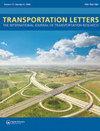Effective passenger flow congestion propagation model for multi-mode rail transit networks
IF 3.3
3区 工程技术
Q2 TRANSPORTATION
Transportation Letters-The International Journal of Transportation Research
Pub Date : 2025-08-09
DOI:10.1080/19427867.2024.2418215
引用次数: 0
Abstract
During peak passenger flow periods, congestion propagation directly affects the operational safety and efficiency of multi-mode rail transit interconnections. By analyzing the key factors affecting congestion propagation, such as the train stop schedule, and considering parameters such as the basic reproduction number and propagation threshold, this study proposes a multi-mode rail transit susceptible-infected-recovered-susceptible (MRT-SIRS) epidemic model to analyze passenger flow congestion propagation. Simulation experiments and sensitivity analyses using data from the multi-mode rail transit in Beijing, China, were conducted to examine the influence mechanism of key factors on congestion propagation. The degree of influence of each factor was investigated using Gray correlation analysis. Each key factor, including the propagation and recovery rates, influences congestion propagation differently. The results of this study may provide theoretical support for the efficient operation and management of multi-mode rail transit systems.
多模式轨道交通网络的有效客流拥堵传播模型
在客流高峰时段,拥堵的传播直接影响多模式轨道交通互联的运行安全性和效率。通过分析列车停靠时间等影响拥堵传播的关键因素,并考虑基本繁殖数和传播阈值等参数,提出了多模式轨道交通易感-感染-恢复-易感(MRT-SIRS)流行模型来分析客流拥堵传播。以北京市多模式轨道交通数据为研究对象,通过仿真实验和敏感性分析,探讨了关键因素对拥堵传播的影响机制。采用灰色关联分析对各因素的影响程度进行了研究。每个关键因素,包括传播速率和恢复速率,对拥塞传播的影响是不同的。研究结果可为多模式轨道交通系统的高效运行和管理提供理论支持。
本文章由计算机程序翻译,如有差异,请以英文原文为准。
求助全文
约1分钟内获得全文
求助全文
来源期刊

Transportation Letters-The International Journal of Transportation Research
TRANSPORTATION SCIENCE & TECHNOLOGY-
CiteScore
6.40
自引率
14.30%
发文量
79
审稿时长
>12 weeks
期刊介绍:
Transportation Letters: The International Journal of Transportation Research is a quarterly journal that publishes high-quality peer-reviewed and mini-review papers as well as technical notes and book reviews on the state-of-the-art in transportation research.
The focus of Transportation Letters is on analytical and empirical findings, methodological papers, and theoretical and conceptual insights across all areas of research. Review resource papers that merge descriptions of the state-of-the-art with innovative and new methodological, theoretical, and conceptual insights spanning all areas of transportation research are invited and of particular interest.
 求助内容:
求助内容: 应助结果提醒方式:
应助结果提醒方式:


